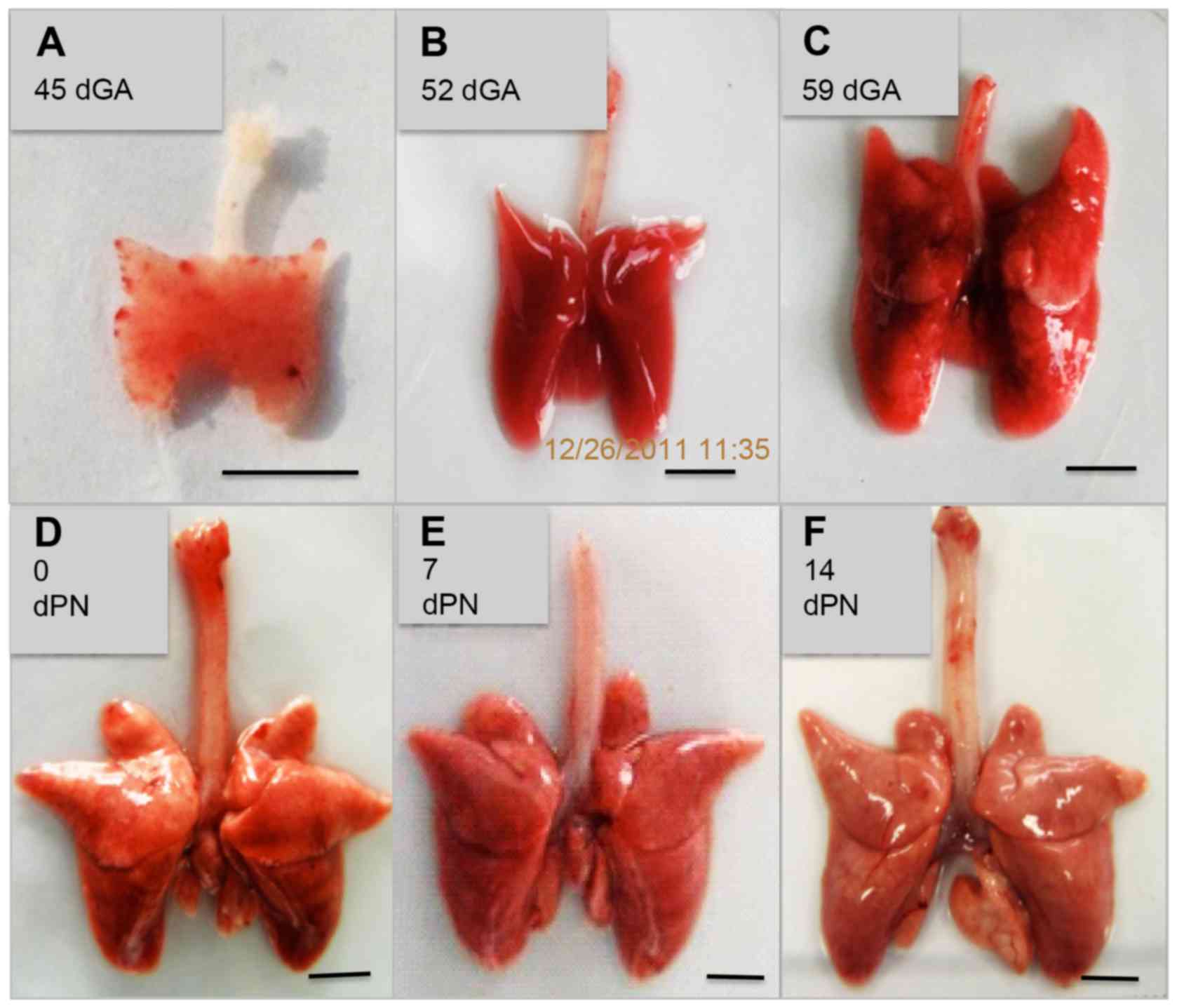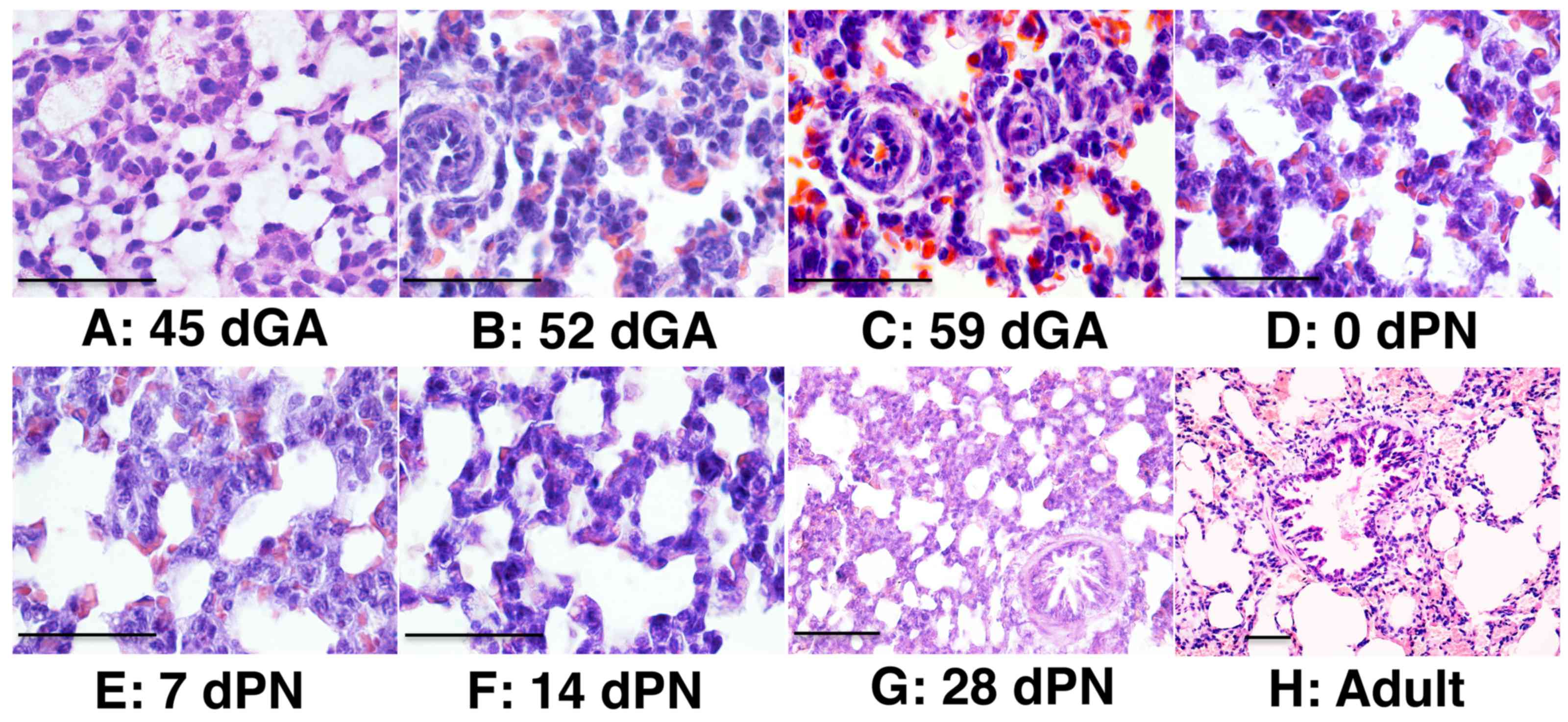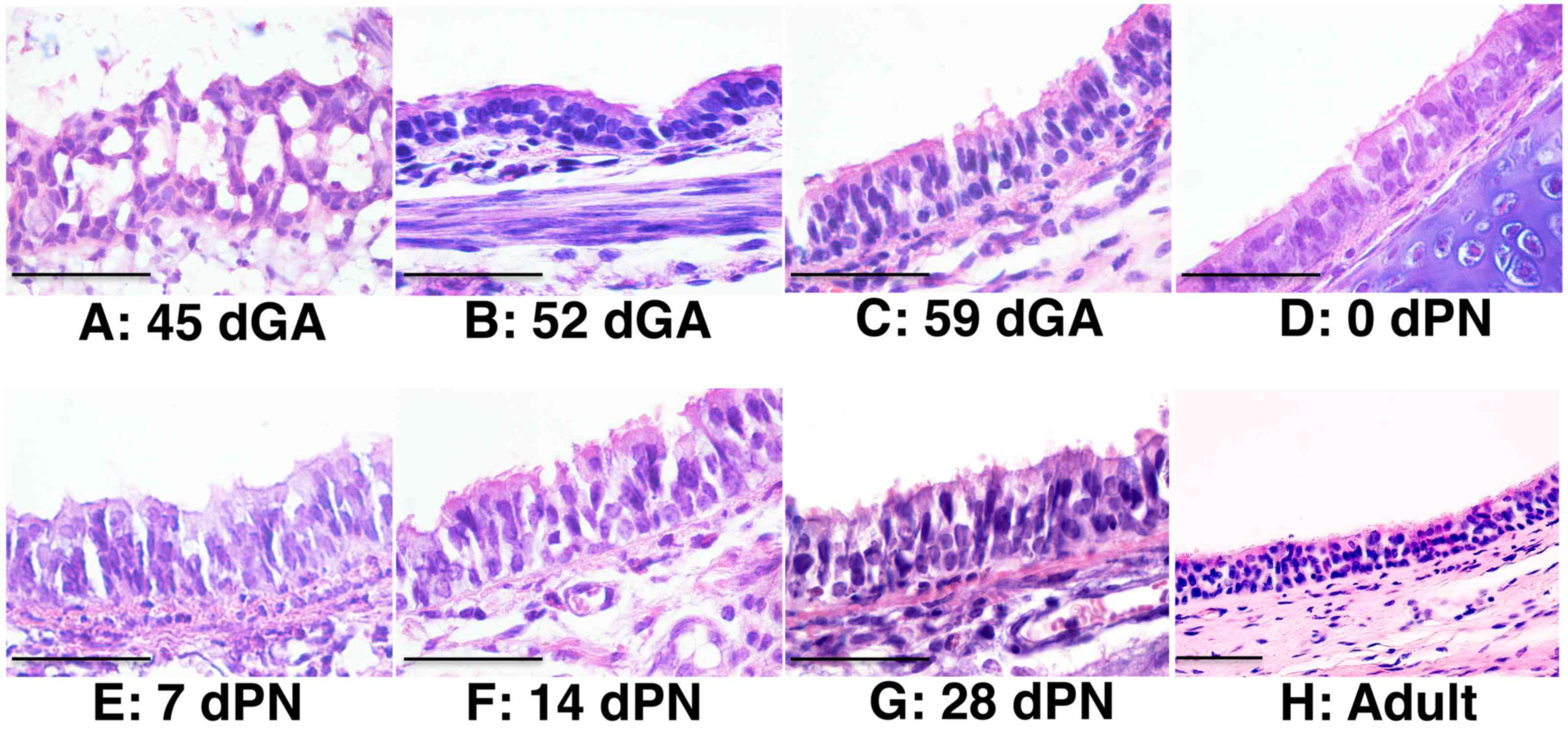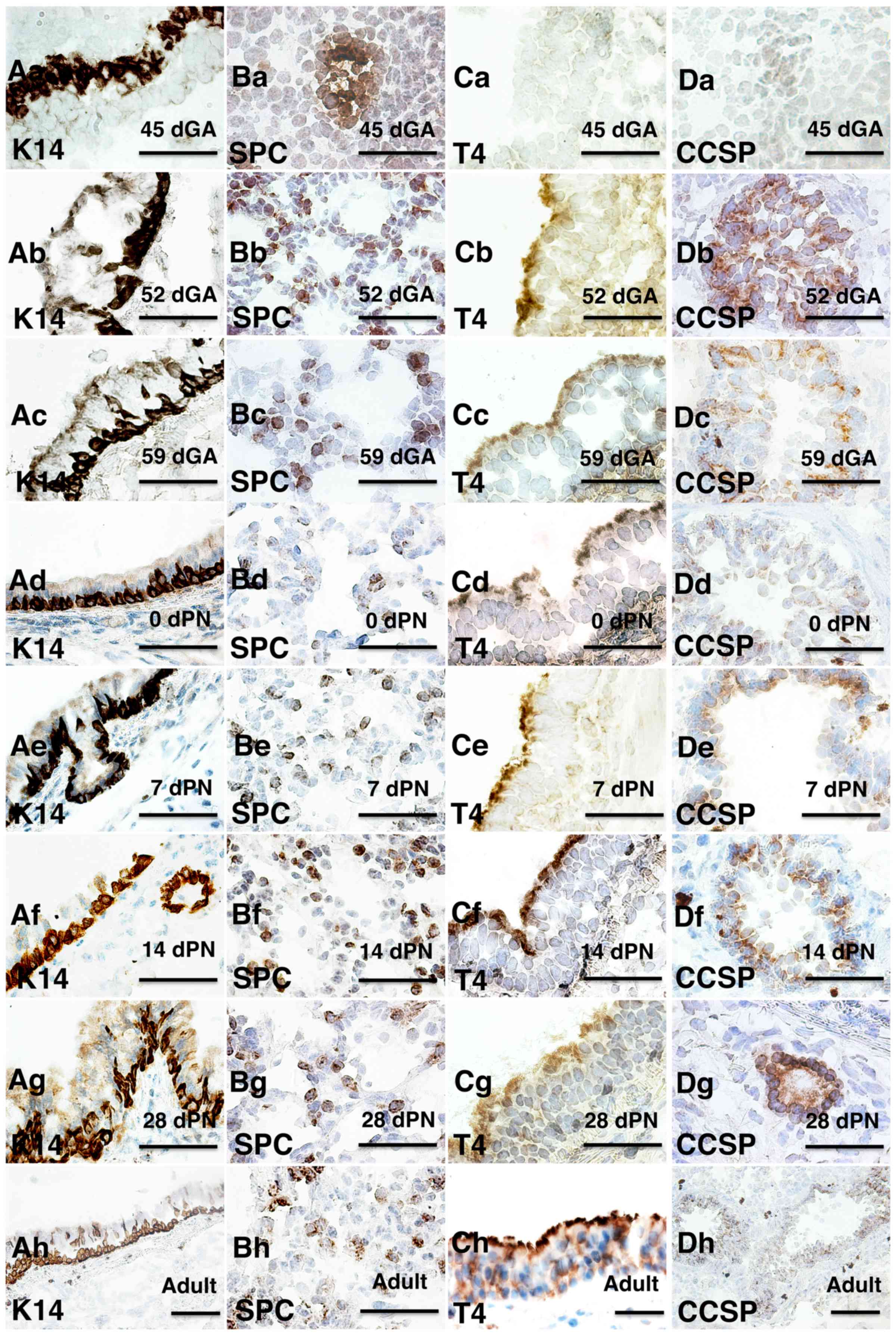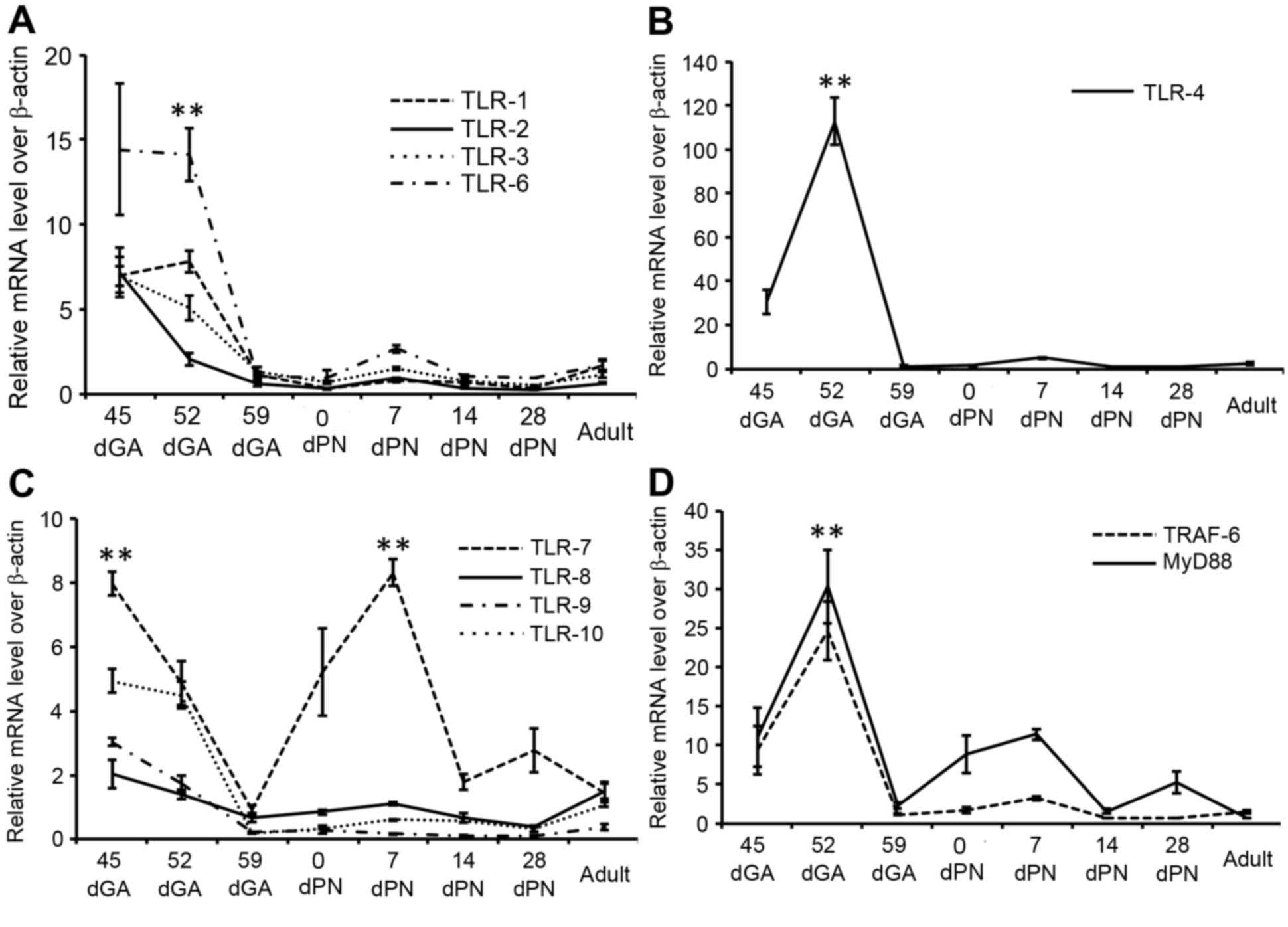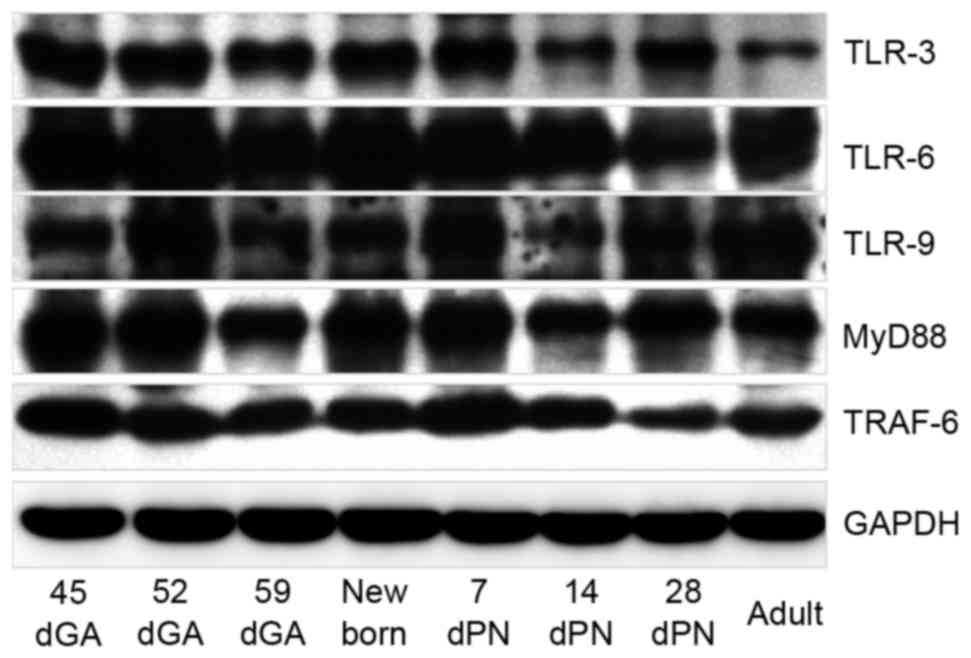Developmental expression of Toll‑like receptors in the guinea pig lung
- Authors:
- Published online on: January 17, 2017 https://doi.org/10.3892/mmr.2017.6129
- Pages: 1243-1251
-
Copyright: © Ma et al. This is an open access article distributed under the terms of Creative Commons Attribution License.
Abstract
Introduction
The guinea pig (Cavia porcellus) is a rodent species in the Caviidae family (1,2). Guinea pigs are a valuable animal model for the study of developmental biology and the pathogenesis of multiple diseases due to similarities between their biological characteristics and those of humans. These similarities appear in hormonal and immunologic responses, pulmonary physiology, exogenous vitamin C requirements and delayed-type hypersensitivity to infections such as tuberculosis (3). Similarities in the sensitivity of the respiratory system and susceptibility to infectious agents results in the broad use of this species as a model of respiratory diseases (4). With respect to the pathogenesis and the immune response to these diseases, guinea pigs are more representative of a human than models using other rodent species.
The lung is an organ directly exposed to the environment, resulting in continuous contact with a diverse array of environmental insults. To respond to the internal and/or external environment, resident myeloid cells and stromal cells of the lung express a full complement of Toll-like receptors (TLRs), which are a class of signaling pattern-recognition receptors (PRRs) that contribute to innate and adaptive immunity by recognizing pathogen-associated molecular patterns (PAMPs) and endogenous danger-associated molecular patterns (DAMPs) (5,6). In addition, TLRs are implicated in the pathogenesis of non-infectious pulmonary diseases, including pulmonary fibrosis, chronic obstructive pulmonary disease (COPD) and acute lung injury (ALI) (7). TLRs were originally identified in Drosophila melanogaster, and revealed to be transmembrane receptor proteins that are highly conserved between D. melanogaster and humans (8,9). Although a large body of studies have demonstrated the association of TLRs with various pulmonary disorders in adult animal models and adult patients (7), several studies on fetal animals, including fetal murine and preterm lamb lung tissue specimens, have suggested that steady-state TLR mRNA expression levels increase with gestational development (10,11). Distinct characteristics and expression patterns of TLRs have also been reported between mammalian species, tissues and developmental stages (12–17). Therefore, in order to improve understanding of the mechanisms involved in cell specificity and regulation of TLR signaling transduction pathways, there is a need to investigate the nature of TLRs and ligands in different species.
Given the importance of TLRs in the development and homeostasis of tissues, the present study examined the differentiation of guinea pig lung epithelial cells during embryonic development and maturation following birth, and profiled the expression of TLRs (TLR-1, TLR-1, TLR-3, TLR-4, TLR-6, TLR-7, TLR-8, TLR-9 and TLR-10), as well as adaptors of the TLR pathway: Myeloid differentiation factor 88 (MyD88) and tumor necrosis factor receptor associated factor 6 (TRAF-6).
Materials and methods
Animals and tissue processing
All experimental procedures were carried out according to ethical guidelines established by Ningxia University and were approved by the Ethnic Committee for Scientific Research of General Hospital of Ningxia Medical University (NXMU-H-2014-250; Yinchuan, China). A total of 51 three months old outbred Hartley-Duncan guinea pigs of both sexes (45 females and 6 males; 300±50 g) were obtained from the Animal Facility of Ningxia Medical University (Yinchuan, China). Total of 51 animals (45 females and 6 males) were used. Individuals were housed in the animal facility under clean, non-specific pathogen free conditions with a constant temperature of 24–26°C and humidity of 30–50% (12/12 h light/dark cycle), provided a proper balance of pellets, hay and fresh vegetables and free access to water, according to the Housing and Husbandry Guidelines for Laboratory Animals of Ningxia Medical University. The appearance of a vaginal plug in the morning following breeding was designated the first day of gestation (dGA). Animals were terminally euthanized by intraperitoneal injection of sodium pentobarbital (150 mg/kg) in the facility. Embryos were harvested from pregnant animals for lung isolation at 45, 52 and 59 dGA (embryos implanted in uterus with normal development were confirmed as alive, and those only showing implantation sites but without an embryo or a normally developed embryo were defined as dead), and lungs were harvested directly from pups 0, 7, 14 and 28 days following parturition (dPN). Lungs were also harvested from mature animals (6 weeks old). The trachea and lungs were removed and fixed in 10% neutral buffered formalin, then processed for embedding in a Sakura Tissue Tek Paraffin Tissue Processor (Model VIP E150; Sakura Finetek USA, Inc., Torrance, CA, USA).
Immunohistochemistry (IHC)
Immunohistochemical staining was performed on 6 µm thick paraffin sections. Paraffin sections were dewaxed in xylene and incubated in methanol containing 0.3% H2O2 for 30 min to inactivate endogenous peroxidase. Sections were subsequently rehydrated with graded ethanol according to histological standards. The sections were boiled in in citrate buffer (pH 6.0) at 95°C for 20 min for antigen retrieval followed by slow cooling for 2 h at room temperature. Sections were then blocked using a blocking buffer (5% horse serum in PBS; Vector Laboratories, Inc., Burlingame, CA, USA) at room temperature for 2 h prior to incubation with a primary antibody (diluted in blocking buffer; Table I) in a humid chamber at 4°C overnight. The primary antibodies used in the present study are listed in Table I. Following washing three times for 5 min in PBS, a mixture of biotinylated horse anti-rabbit IgG or anti-mouse IgG (cat. no. PK-6100; 1:200; Vector Laboratories, Inc.) secondary antibodies (Table I for detail) was applied at room temperature for 2 h. The antigen was detected with an elite ABC kit (Vector Laboratories, Inc.) and developed with a DAB peroxidase substrate kit (Vector Laboratories, Inc.). The stained sections were counterstained with hematoxylin for 10 sec (Gill's formula; Vector Laboratories, Inc.). Sections were subsequently rinsed in running tap water for 5 min, dehydrated with gradually increased concentration of ethanol (30–100% v/v), cleared sections by submerging slides in xylene for 1 min during mounting sections with Permount (Thermo Fisher Scientific, Inc., Waltham, MA, USA). Hematoxylin and eosin (H&E) staining was performed using H&E staining kit from Thermo Fisher Scientific, Inc.. Periodic Acid Schiff's staining was conducted using Schiff's reagents from Sigma-Aldrich; Merck Millipore. Staining was visualized under a light microscope (TCS SP8; Leica, Wetzlar, Germany) at magnifications of ×200, ×400 and ×630, and images were captured using a Leica DFC300 F camera (Leica Microsystems, Inc., Buffalo Grove, IL, USA). For all antibodies tested, mouse positive and negative tissues were utilized as positive and negative controls, respectively.
RNA extraction and reverse transcription-quantitative polymerase chain reaction (RT-qPCR)
Total RNA was extracted from each tissue sample using TRIzol reagent (Thermo Fisher Scientific, Inc., Waltham, MA, USA) according to the manufacturer's instructions. RNA quality was assayed by calculation of the RNA integrity number (RIN) (18). High quality RNA (RIN value >7.5) was used to synthesize first strand cDNA using M-MLV reverse transcriptase (Takara Bio, Inc., Otsu, Japan). qPCR was performed in the Roche LightCycler 2.0 (Roche Diagnostics, Basel, Switzerland) using a SYBR-Green I kit (Takara Bio, Inc.). The thermal cycling conditions were as follows: 95°C for 30 sec, 40 cycles of 95°C for 5 sec, 60°C for 20 sec and 72°C for 20 sec, followed by 40°C for 20 min. The primer sets used for β-actin control, TLRs, MyD88 and TRAF-6 are listed in Table II. To assess primer efficiency, standard curves for each primer pair were generated using serially diluted transcribed cDNA samples. PCR efficiency was calculated from the slope of the standard curves. β-actin internal controls were always included to normalize each reaction with respect to RNA integrity, sample loading and inter-PCR variations. The relative expression ratio was calculated from the real-time PCR efficiencies and the crossing point deviation of experimental samples vs. controls (19). The resulting threshold cycle (Cq) values were normalized to the endogenous control, β-actin (ΔCq=Cq value of target gene-Cq value of β-actin). Dissociation analysis of amplification products was performed at the end of each PCR to confirm the specificity of the amplicon. The fold change in TLR gene expression during lung development was calculated by the 2-ΔΔCq method (20).
Western blot analysis
Tissue extracts were prepared by homogenizing the cells in a lysis buffer (50 mM Tris-HCl, 5 mM EDTA, 150 mM NaCl, 0.5% NP-40; pH 7.5) for 60 min on ice. Lysates were subsequently centrifuged at 10,000 × g for 10 min at 4°C, and the supernatants were collected as whole-cell extracts. The soluble protein concentration was measured with the Bio-Rad Protein Assay (Bio-Rad Laboratories, Inc., Hercules, CA, USA) using bovine serum albumin (BSA; Thermo Fisher Scientific, Inc.) as a standard. The cell extracts (50 µg) were separated by 10% sodium dodecyl sulfate-polyacrylamide gel (SDS-PAGE) and transferred to a polyvinylidene difluoride membrane (Merck Millipore). The membrane was blocked with 4% fat free dry milk in PBS containing 0.2% Tween-20 at room temperature for 2 h and incubated with primary antibodies (Table I) at 4°C overnight, followed by appropriate peroxidase-labeled secondary antibodies (cat. no. 108894; 1:2,000; Jackson ImmunoResearch Laboratories, Inc., West Grove, PA, USA) at room temperature for 1 h. The blots were then developed using an enhanced chemiluminescence reagent (GE Healthcare, Chalfont, UK).
Statistical analysis
All data collected in the present study were obtained from at least three independent experiments for each condition. SPSS 18.0 analysis software (SPSS, Inc., Chicago, IL, USA) was used for statistical analysis. Statistical evaluation of the data was performed by one-way ANOVA and Student's t-tests to compare differences between groups. Tukey's honestly significant difference test was employed for post hoc testing for multiple comparisons. P<0.05 was considered to indicate a statistically significant difference and P<0.01 was considered to indicate a highly statistically significant difference. Data were expressed as the mean ± standard deviation.
Results
Development of the guinea pig lung during embryogenesis
The guinea pig gestation period spans 59–73 days, with an average of 66±2 days recorded in the present study. Lobe formation in the lung was displayed at 45 dGA, with all 7 lobes (4 lobes in the right, 3 lobes in the left) formed at 59 dGA, as determined by whole mount anatomic lung morphological examination (Fig. 1). The lung continued to grow and mature, increasing in weight and size, with body growth (Fig. 1 and Table III). Histological analysis by H&E staining revealed that primary alveolar sacs had formed by 45 dGA, and bronchiolar structure was first observed in the distal lung of 52 dGA embryos (Fig. 2). Well-structured alveolar epithelia and bronchiolar epithelia were observed at 52 dGA and onward (Fig. 2). Epithelial cells in the trachea of 45 dGA embryos were poorly differentiated, despite the formation of a primary epithelial structure at this stage (Fig. 3). Abundant epithelial cells were observed on the surface of 52 dGA tracheas, but pseudostratified epithelial layers with ciliated cells were only observed in 59 dGA tracheas and onward (Fig. 3).
Expression of epithelial cell type-specific markers in the developing guinea pig lung
The expression of epithelial cell markers (21) in developing guinea pig lungs was examined using IHC analysis. At 45 dGA, keratin 14 (K14) was expressed in the basal layer of the tracheal epithelia (Fig. 4Aa) and pro-surfactant protein C (SPC) of alveolar type II cells was expressed in the lung (Fig. 4Ba), but there was no expression of β-tubulin IV (T4) of ciliary axonemes in the tracheal ciliated cells (Fig. 4C) or secretoglobin family1A member 1 (CCSP) of cube cells in the distal airway (Fig. 4D) at this gestation age (21). However, these 4 cell-specific markers were expressed in the lung of 52 dGA embryos and onward, particularly the CCSP was mainly expressed in epithelial cells of small airways in distal lung (Fig. 4), indicating that differentiation of varied epithelial cell types occurs during lung development in the guinea pig.
Developmental expression of TLRs in the lung of guinea pig
In order to evaluate changes of mRNA and protein expression levels of TLR signaling components during organogenesis and maturation of the lung in guinea pigs, the relative abundance of TLRs (−1, −2, −3, −4, −6, −7, −8, −9 and −10), MyD88 and TRAF-6 were investigated by RT-qPCR and western blotting, respectively, in distal lung tissues at 45, 52 and 59 dGA, 0, 7, 14 and 28 dPN, and in adult animals. RT-qPCR analysis demonstrated that the mRNA expression levels of all tested TLR signaling components was dynamic, with a similar expression pattern, in which transcripts were more abundant in the 45 dGA and 52 dGA lungs compared with later stages (Fig. 5A-D). Notably, TLR-2, −3, −6, −7, −8, −9 and −10 mRNA expression levels were higher in 45 dGA lungs compared with 52 dGA lungs (Fig. 5A and C), while TLR-1, −4, MyD88 and TRAF-6 mRNA expression levels were higher in 52 dGA lungs compared with 45 dGA lungs (Fig. 5A, B and D). In addition, increased TLR-7 mRNA expression levels were observed in 7 dPN lungs as compared with TLR-8, 9 and 10 at this stage (P=0.000; Fig. 5C). The results of western blotting demonstrated similar expression patterns to the RT-qPCR analysis for TLR-3, −6, −9, MyD88 and TRAF-6 proteins, with differential expression in guinea pig lungs during different developmental stages (Fig. 6). These data imply that TLR expression in guinea pig lungs is developmentally regulated.
Discussion
In the present study, the morphogenesis and maturation of the guinea pig lung and the expression of TLR ligands and TLR signaling adaptors MyD88 and TRAF-6 were investigated from 45 dGA to maturation. Lung development was observed at as early as 45 dGA, along with expression of the basal cell marker K14 and alveolar type II cell marker SPC, but the cube cell marker CCSP and ciliated cell marker T4 were only observed in the lungs from 52 dGA onwards. Notably, the expression of all 9 examined TLRs and the TLR signaling adaptors MyD88 and TRAF-6 were detected at the transcriptional level in all lung tissues harvested from 45, 52 and 59 dGA, 0, 7, 14 and 28 dPN, and in adult animals. Transcript levels of all TLR signaling components formed similar dynamic expression patterns with gestation age and maturation time following parturition, with TLRs significantly more abundant in the lungs of 45 and 52 dGA embryos compared with later stages. These data imply that TLR expression in guinea pig lungs may be developmentally regulated.
TLRs are a family of mammalian proteins first observed in D. melanogaster (5). To date, 11 TLRs have been identified in humans (5). Different TLR ligands have been demonstrated to be involved in in the regulation of both innate and adaptive immune responses, in part through binding to different specific ligands. TLR-2 forms heterodimers with TLR-1 and TLR-6 upon binding to different lipopeptide and lipoprotein structures (22); TLR-2 and TLR-4 recognize lipids including lipopolysaccharide (LPS); TLR-3 and TLR-7-9 are activated by nucleic acids derived from viruses or bacteria, and TLR-5 primarily recognizes the protein flagellin from flagellated bacteria (23). In particular, TLR-9 recognizes various types of unmethylated cytosine-guanine repeat dideoxynucleotides (24). TLR-10, an orphan receptor with an unidentified ligand, is the most recent human TLR to be identified, and has been demonstrated to form heterodimers with TLR-1 and TLR-2 (22,25). TLR-10 mRNA expression was detected in guinea pig lungs in the present study.
In addition to immunoregulation, TLRs are involved in development and homeostasis, sensing endogenously derived materials during the processes of organogenesis and tissue generation. For example, hyaluronan (HA) is a breakdown product of extracellular matrix components, and the recognition of different forms of HA is essential for the maintenance of homeostasis and epithelial integrity during tissue regeneration following an injury and the restoration of normal tissue architecture (26–28). Several lines of evidence have demonstrated the developmental involvement of TLRs in mammalian and non-mammalian species during embryogenesis. For example, Kannaki et al (29) demonstrated differential expression patterns of TLR mRNAs during chicken embryological development, suggesting the potential involvement of TLRs in the regulation of chicken embryo development. This is supported by the initial discovery of Toll in D. melanogaster, the first member of the TLR family, as it was initially characterized as a developmental protein prior to the establishment of its immunological involvement (8,15). This is further supported by the discovery of the developmental involvement of TLR-7 and TLR-9 in the vertebrate brain (16).
The immunological and developmental involvements of TLRs in embryonic organogenesis have also been reported in mammalian lungs and other epithelial tissues (17,30). For example, in a study evaluating the developmental expression of TLR-2 and TLR-4 in preterm baboon lungs, Awasthi et al (30) demonstrated that the expression of these TLRs was significantly lower at 125 and 140 dGA compared with adult baboons, only reaching comparable levels at 175 dGA. This indicates that that TLR expression in baboon lungs is developmentally regulated. This developmental expression pattern was consistent with previous findings in fetal murine lung tissues (10) and in preterm lamb lung tissues (11), with TLR expression increasing with the length of gestation. This expression pattern may be different to that observed in the mature lung of adult animals and humans, where the expression of TLRs is dependent on immune cells including macrophages, dendritic cells and lung epithelial cells (7,31). In addition, developmentally regulated expression of TLRs was observed in fetal and neonatal human and mouse colonic epithelium (17). The results of the present study were consistent with these previous findings, with the expression of TLRs also being developmentally regulated in the guinea pig lung. Altered TLR signaling may lead to compromised structural development in the lung, as previously demonstrated in mice (32). An injection of LPS into the amniotic fluid of 15 dGA mice led to increases in the luminal volume density and decreases in distal branching of the lungs at 17 and 18 dGA, induced by activation of functional TLR-4 (32). Notably, in the present study, TLR mRNA expression levels were highest in guinea pig lungs at 45 and 52 dGA, and dramatically decreased as lung organogenesis and maturation progressed. Adult levels were reached by 59 dGA. The implications of such a dramatic change in TLR expression in the guinea pig lung warrants further investigation.
To conclude, morphogenesis and developmental expression of TLR signaling components in the guinea pig lung were examined in the present study. The dynamic expression of TLRs during lung development and maturation in the guinea pig was demonstrated, further confirming the developmental involvement of TLRs in lung morphogenesis in this animal model. These data lay a foundation upon which further understanding of the immunoregulatory mechanisms in the guinea pig lung may be built.
Acknowledgements
The present study was supported by grants from the National Natural Science Foundation of China (grant nos. 31260615 and 31472191).
References
|
D'Erchia AM, Gissi C, Pesole G, Saccone C and Arnason U: The guinea-pig is not a rodent. Nature. 381:597–600. 1996. View Article : Google Scholar : PubMed/NCBI | |
|
Graur D, Hide WA and Li WH: Is the guinea-pig a rodent? Nature. 351:649–652. 1991. View Article : Google Scholar : PubMed/NCBI | |
|
Padilla-Carlin DJ, McMurray DN and Hickey AJ: The guinea pig as a model of infectious diseases. Comp Med. 58:324–340. 2008.PubMed/NCBI | |
|
Kashino SS, Napolitano DR, Skobe Z and Campos-Neto A: Guinea pig model of Mycobacterium tuberculosis latent/dormant infection. Microbes Infect. 10:1469–1476. 2008. View Article : Google Scholar : PubMed/NCBI | |
|
Takeda K and Akira S: TLR signaling pathways. Semin Immunol. 16:3–9. 2004. View Article : Google Scholar : PubMed/NCBI | |
|
Jimenez-Dalmaroni MJ, Gerswhin ME and Adamopoulos IE: The critical role of toll-like receptors-From microbial recognition to autoimmunity: A comprehensive review. Autoimmun Rev. 15:1–8. 2016. View Article : Google Scholar : PubMed/NCBI | |
|
Kovach MA and Standiford TJ: Toll like receptors in diseases of the lung. Int Immunopharmacol. 11:1399–1406. 2011. View Article : Google Scholar : PubMed/NCBI | |
|
Hashimoto C, Hudson KL and Anderson KV: The Toll gene of Drosophila, required for dorsal-ventral embryonic polarity, appears to encode a transmembrane protein. Cell. 52:269–279. 1988. View Article : Google Scholar : PubMed/NCBI | |
|
De Nardo D: Toll-like receptors: Activation, signalling and transcriptional modulation. Cytokine. 74:181–189. 2015. View Article : Google Scholar : PubMed/NCBI | |
|
Harju K, Glumoff V and Hallman M: Ontogeny of Toll-like receptors Tlr2 and Tlr4 in mice. Pediatr Res. 49:81–83. 2001. View Article : Google Scholar : PubMed/NCBI | |
|
Meyerholz DK, Kawashima K, Gallup JM, Grubor B and Ackermann MR: Expression of select immune genes (surfactant proteins A and D, sheep beta defensin 1, and toll-like receptor 4) by respiratory epithelia is developmentally regulated in the preterm neonatal lamb. Dev Comp Immunol. 30:1060–1069. 2006. View Article : Google Scholar : PubMed/NCBI | |
|
Mestas J and Hughes CC: Of mice and not men: Differences between mouse and human immunology. J Immunol. 172:2731–2738. 2004. View Article : Google Scholar : PubMed/NCBI | |
|
Schneberger D, Caldwell S, Suri SS and Singh B: Expression of toll-like receptor 9 in horse lungs. Anat Rec (Hoboken). 292:1068–1077. 2009. View Article : Google Scholar : PubMed/NCBI | |
|
Singh Suri S, Janardhan KS, Parbhakar O, Caldwell S, Appleyard G and Singh B: Expression of toll-like receptor 4 and 2 in horse lungs. Vet Res. 37:541–551. 2006. View Article : Google Scholar : PubMed/NCBI | |
|
Kambris Z, Hoffmann JA, Imler JL and Capovilla M: Tissue and stage-specific expression of the Tolls in Drosophila embryos. Gene Expr Patterns. 2:311–317. 2002. View Article : Google Scholar : PubMed/NCBI | |
|
Kaul D, Habbel P, Derkow K, Krüger C, Franzoni E, Wulczyn FG, Bereswill S, Nitsch R, Schott E, Veh R, et al: Expression of Toll-like receptors in the developing brain. PLoS One. 7:e377672012. View Article : Google Scholar : PubMed/NCBI | |
|
Meng D, Zhu W, Shi HN, Lu L, Wijendran V, Xu W and Walker WA: Toll-like receptor-4 in human and mouse colonic epithelium is developmentally regulated: A possible role in necrotizing enterocolitis. Pediatr Res. 77:416–424. 2015. View Article : Google Scholar : PubMed/NCBI | |
|
Schroeder A, Mueller O, Stocker S, Salowsky R, Leiber M, Gassmann M, Lightfoot S, Menzel W, Granzow M and Ragg T: The RIN: An RNA integrity number for assigning integrity values to RNA measurements. BMC Mol Biol. 7:32006. View Article : Google Scholar : PubMed/NCBI | |
|
Pfaffl MW: A new mathematical model for relative quantification in real-time RT-PCR. Nucleic Acids Res. 29:e452001. View Article : Google Scholar : PubMed/NCBI | |
|
Livak KJ and Schmittgen TD: Analysis of relative gene expression data using real-time quantitative PCR and the 2(−Delta Delta C(T)) Method. Methods. 25:402–408. 2001. View Article : Google Scholar : PubMed/NCBI | |
|
Li Y, Wang J, He HY, Ma LJ, Zeng J, Deng GC, Liu X, Engelhardt JF and Wang Y: Immunohistochemical demonstration of airway epithelial cell markers of guinea pig. Tissue Cell. 43:283–290. 2011. View Article : Google Scholar : PubMed/NCBI | |
|
Ospelt C and Gay S: TLRs and chronic inflammation. Int J Biochem Cell Biol. 42:495–505. 2010. View Article : Google Scholar : PubMed/NCBI | |
|
Takeda K and Akira S: Toll receptors and pathogen resistance. Cell Microbiol. 5:143–153. 2003. View Article : Google Scholar : PubMed/NCBI | |
|
Bauer S: Toll-like receptor 9 processing: The key event in Toll-like receptor 9 activation? Immunol Lett. 149:85–87. 2013. View Article : Google Scholar : PubMed/NCBI | |
|
Hasan U, Chaffois C, Gaillard C, Saulnier V, Merck E, Tancredi S, Guiet C, Brière F, Vlach J, Lebecque S, et al: Human TLR10 is a functional receptor, expressed by B cells and plasmacytoid dendritic cells, which activates gene transcription through MyD88. J Immunol. 174:2942–2950. 2005. View Article : Google Scholar : PubMed/NCBI | |
|
Jiang D, Liang J, Fan J, Yu S, Chen S, Luo Y, Prestwich GD, Mascarenhas MM, Garg HG, Quinn DA, et al: Regulation of lung injury and repair by Toll-like receptors and hyaluronan. Nature Med. 11:1173–1179. 2005. View Article : Google Scholar : PubMed/NCBI | |
|
O'Neill LA: TLRs play good cop, bad cop in the lung. Nature Med. 11:1161–1162. 2005. View Article : Google Scholar : PubMed/NCBI | |
|
Sabroe I, Parker LC, Dower SK and Whyte MK: The role of TLR activation in inflammation. J Pathol. 214:126–135. 2008. View Article : Google Scholar : PubMed/NCBI | |
|
Kannaki TR, Reddy MR, Verma PC and Shanmugam M: Differential Toll-like receptor (TLR) mRNA expression patterns during chicken embryological development. Animal Biotechnol. 26:130–135. 2015. View Article : Google Scholar | |
|
Awasthi S, Cropper J and Brown KM: Developmental expression of Toll-like receptors-2 and −4 in preterm baboon lung. Dev Comp Immunol. 32:1088–1098. 2008. View Article : Google Scholar : PubMed/NCBI | |
|
Armstrong L, Medford AR, Uppington KM, Robertson J, Witherden IR, Tetley TD and Millar AB: Expression of functional toll-like receptor-2 and −4 on alveolar epithelial cells. Am J Respir Cell Mol Biol. 31:241–245. 2004. View Article : Google Scholar : PubMed/NCBI | |
|
Prince LS, Dieperink HI, Okoh VO, Fierro-Perez GA and Lallone RL: Toll-like receptor signaling inhibits structural development of the distal fetal mouse lung. Dev Dyn. 233:553–561. 2005. View Article : Google Scholar : PubMed/NCBI |



